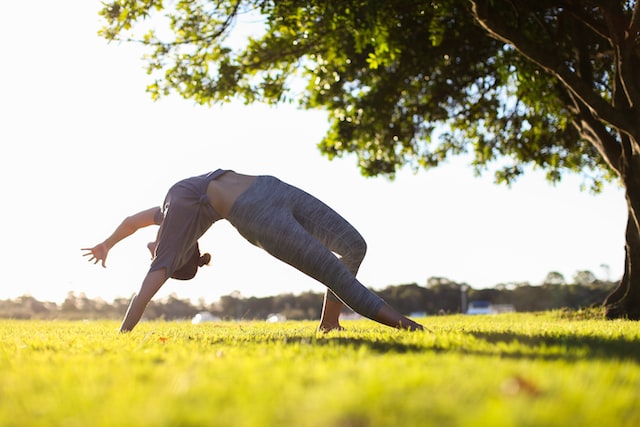ライフハックとしてではなく、英語学習にも極めて有用なのが、著名人が10分程度のプレゼンを行うTEDです。
TED Talksとは、あらゆる分野のエキスパートたちによるプレゼンテーションを無料で視聴できる動画配信サービスのことです。10年ほど前にサービスが開始されてから、政治、心理学、経済、日常生活などの幅広いコンテンツが視聴できることから人気を集めています。
RareJob English Lab
TEDは4000を超える膨大な数の動画があります。しかし慣れないうちは、動画の探し方や視聴のコツが分かりませんよね。この記事では、数多くのTEDを見てきた管理人(塩@saltandshio)が、心を揺さぶられたトークをあらすじと一緒にご紹介します。
ビジネス英会話を効率よく身につけたい方におすすめスクール
シェーン英会話
シェーンは1977年の創業以来、ネイティブ講師が英語を英語で教える「直接教授法」を採用しています。首都圏におけるスクール拠点数は、ネイティブ講師の英会話スクールでNo.1。駅から近いスクールが多いので通いやすく時間を有効に使えます。
スピークバディ パーソナルコーチング
1日1時間の短期集中トレーニングで、あなたの英語力向上をコーチが全力でサポートします。あなたの英語の世界が、劇的に変わります。
クリシュナ・スディール:ヨガが体と心に与える影響
現在、様々な種類のヨーガがありますが、ほとんどが3つの核となる要素、つまり ポーズ、呼吸法、瞑想法を保持しています。ヨガは身体的・精神的要素が融合した運動で、健康に良い影響を与えると広く考えられています。しかし、ヨガは本当に健康に良いのでしょうか。クリシュナ・スディールが、体と心へのヨガの影響を検証します(約5分半)。Krishna Sudhir / What yoga does to your body and brain.
[PR]【楽天ランキング四冠受賞】インストラクター愛用ヨガマット これであなたもスリムボディ!ヨガ(YOGA)とはなにか
近年、世界的に人気が高まっているヨガですが、家にいる時間が増えたいまではさらに人気が高まっているエクササイズです。ダイエットや呼吸法、はたまた美容などで知られるヨガですが、そもそもヨガとは一体なんなのでしょうか。
「ヨガ」とはサンスクリット語で「つながり」を意味しています。心と体、魂が繋がっている状態のことを表します。呼吸、姿勢、瞑想を組み合わせて、心身の緊張をほぐし、心の安定とやすらぎを得るものです。具体的には「調和」「統一」「バランス」を意味し、体・心・呼吸・食べ物など、あらゆるカテゴリーと関係しています。
ヨガの目的と効果 / 日本ヨガ連盟
ヨガの歴史は古く、1世紀から5世紀のある時期にヒンドゥー教の聖人であるパタンジャリが、古来からインド全土で実践されてきた瞑想の伝統を体系化して196節から成る「ヨーガスートラ」にまとめたものです。
その教典で、ヨガは“くびきをつける” と定義されています。外界の事物に向かぬよう心を抑制し、“純粋意識”の状態に至ることを目指すのです。
These texts defined yoga as the ‘yoking’ or restraining of the mind from focusing on external objects in efforts to reach a state of pure consciousness.
体系化する途中で、体操やレスリングから身体的要素を取り入れられ、現在では様々な種類のヨガがありますが、ほとんどがパタンジャリの実践したポーズ・呼吸法・瞑想法という、3つの核となる要素を保持しています。では、ヨガがどのように心身に影響を与えるのか順番にみていきましょう。
[PR]【ランキング1位獲得!】ヨガウェア 20カラーから選べる使えるバックデザイントップスヨガが健康に与える影響について
ヨーガは、身体的・精神的要素が融合した運動で、健康に良い影響を与えると広く考えられています。
例えば、筋力や柔軟性を高め、心肺機能を向上し精神的な健康状態を良好にします。
Such as improving strength and flexibility, boosting heart and lung function, and enhancing psychological well-being.
古来から健康にいいことがわかっているヨガですが、じつは現代の研究ではいまだに解明されていない謎がたくさんあります。多くの研究者が試みましたが、ヨガの効能に関して断言することはむずかしく、独特な動作の組み合わせ方がどのように体に影響を及ぼしているのかは、いまだ解明されていないのです。
しかし、体を曲げてヨガのポーズをとることは、多数の筋群が伸びて柔軟性と筋力を向上させます。さらに、定期的にストレッチを行うことによって、時間をかけて幹細胞が刺激され新たな筋肉組織が生成されるので、柔軟性が高まり痛みへの耐性も向上します。
しかし、ほかの負荷が少ない運動と同様に、ヨガは健康な人々の健康と柔軟性を確実に向上させます!
But like other low-impact exercises, yoga reliably improves fitness and flexibility in healthy populations.
ヨガは効果が認められた治療手段である
ヨガを継続的に行うことで筋肉に柔軟性がうまれますが、さらにヨガは体に有効な治療手段であることも知られています。
様々な筋骨格系の疾患をもつ患者に関する研究で、ヨガは体に負担の少ない他の運動よりも、痛みの軽減や可動域の改善に効果があると認められました。
In studies involving patients with a variety of musculo-skeletal disorders, yoga was more helpful at reducing pain and improving mobility than other forms of low-impact exercise.
習慣的に行っている運動にヨガを加えることで、筋力や柔軟性が向上し、慢性的な腰痛や関節リウマチ、さらには骨粗しょう症などに効果があるといわれています。また、ヨガは呼吸と連動しているため、心肺機能への効果も認められています。
さらにヨガにみられる呼吸法は、通路を狭めている筋肉を緩めて酸素の拡散を改善するため、十分な酸素を全身に送るのが困難な心筋が弱い人にとっても効果があります。そして、心臓にとくに問題がないという人でも、筋肉が柔らかくなり血圧も下がるため、将来的に病気を引き起こす危険因子が減らせるのです。
このことから、健康な人でもヨガを行う意義があると十分にいえるでしょう。
ヨガが精神面に与える影響について
ヨガを行うことによって、精神的な健康も保たれるという話はよく知られていますが、残念ながら証拠となるデータはほとんどありません。しかし、うつや不安障害における症状が、ヨガを行うことによって改善したという事例は少なくありません。
しかし、症状の原因や程度が様々であるように、その診断も個々に異なることから、ヨガの影響を測ることは難しいのです。しかし、ストレス症状の軽減にヨガが効果的とする証拠はあります。瞑想や休養も同様です。
Since diagnosis of these conditions varies widely as do their origin and severity, it’s difficult to quantify yoga’s impact. However, there is evidence to suggest that yoga can help reduce the symptoms of stress, as well as meditation or relaxation.
ストレスが溜まっている体は、呼吸が浅くなっています。そのため、ヨガの深い呼吸を繰り返すことで、酸素が全身にいきわたり自律神経が落ち着くのではないかと考えられています。
人の脳の中にある扁桃体という場所は、感情の動き(情動)と呼吸の両方を司っています。そのため緊張や不安、ストレスを感じると速く浅い呼吸になり、反対にリラックスするとゆっくり深い呼吸になります。この情動と呼吸が連動することを『情動呼吸』と呼び、この情動呼吸は、ときに不安やストレスの悪循環を引き起こすことがあります。
呼吸筋ストレッチ体操で息苦しさを改善しよう / 独立行政法人環境再生保全機構
ストレスがたまると体がこわばって、背中が丸くなりがち。こんな姿勢では呼吸が浅くなり、心と体に不調が出やすくなる。そんなこわばった心と体をほぐして、呼吸を深めるのにピッタリなのがヨガ。
「ヨガの呼吸は鼻から吸って吐く鼻呼吸が基本です。ポーズをとらなくても、ラクな姿勢で目を閉じ、呼吸の音やリズムを感じてみましょう。これだけでどんどん呼吸が深まり、心が落ち着いてきますよ」と、ヨガインストラクターのMarikoさん。
ヨガYouTuber Marikoさんに教わる、ヨガで呼吸を深める方法 / Voce
なんだか寝つきが悪い、肩こりや全身がこわばってつらいという人は、ヨガを行ってみましょう。深い呼吸をすることで、心身ともに症状が改善するかもしれません。
2021楽天年間ランキング1位!20〜30代女性プロテイン満足度No1受賞!タンパクオトメまとめ:いまだに謎が解明されていないヨガ
体だけでなく、メンタルの不調にも効果があるといわれているヨガですが、ヨガにまつわる研究はいまだに途中段階です。
今後は、多様な参加者を募り、より大規模に研究する必要があるでしょう。そうすることで、心臓発作や発がん率、認知機能、その他に対するヨガの影響を測ることができるでしょう!
In the future, we’ll need larger studies, incorporating diverse participants, which can measure yoga’s impact on heart attacks, cancer rates, cognitive function and more.
そんな謎が多いヨガですが、現時点でもその効果は多く知られています。最近、なんだかクヨクヨしがち、もしくは運動不足を感じていたら、生活にヨガを取り入れてみてはいかがでしょうか。やる前よりも世界が明るく感じられるかもしれません。
英語全文
At some point between the 1st and 5th century CE, the Hindu sage Patañjali began to codify the ancient, meditative traditions practiced throughout India. He recorded techniques nearly as old as Indian civilization itself in 196 manuals called the Yoga Sutras. These texts defined yoga as the ‘yoking’ or restraining of the mind from focusing on external objects in efforts to reach a state of pure consciousness.
<全文を読む>▼クリック▼
This blend of physical and mental exercise is widely believed to have a unique set of health advantages. Such as improving strength and flexibility, boosting heart and lung function, and enhancing psychological well-being. But what have contemporary studies shown regarding the benefits of this ancient tradition?
Despite attempts by many researchers, it’s tough to make specific claims about yoga’s advantages. Its unique combination of activities makes it difficult to determine which component is producing a specific health benefit. Additionally, yoga studies are often made up of small sample sizes that lack diversity, and the heavy reliance on self-reporting makes results subjective. However, there are some health benefits that have more robust scientific support than others.
Let’s start with flexibility and strength. Twisting your body into yoga’s physical postures stretches multiple muscle groups. In the short term, stretching can change the water content of these muscles, ligaments, and tendons to make them more elastic. Over time, regular stretching stimulates stem cells which then differentiate into new muscle tissue and other cells that generate elastic collagen. Frequent stretching also reduces the body’s natural reflex to constrict muscles, improving your pain tolerance for feats of flexibility.
Researchers haven’t found that any one form of yoga improves flexibility more than another, so the impact of specific postures is unclear. But like other low-impact exercises, yoga reliably improves fitness and flexibility in healthy populations.
The practice has also been shown to be a potentially powerful therapeutic tool. In studies involving patients with a variety of musculo-skeletal disorders, yoga was more helpful at reducing pain and improving mobility than other forms of low-impact exercise. Adding yoga to an existing exercise routine can improve strength and flexibility for hard to treat conditions like chronic lower back pain, rheumatoid arthritis, and osteoporosis.
Yoga’s mix of physical exercise and regimented breathing has proven similarly therapeutic for lung health. Lung diseases like chronic bronchitis, emphysema, and asthma shrink the passageways that carry oxygen, while weakening the membrane that brings oxygen into the blood. But breathing exercises like those found in yoga relax the muscles constricting those passageways and improve oxygen diffusion. Increasing the blood’s oxygen content is especially helpful for those with weak heart muscles who have difficulty pumping enough oxygen throughout the body. And for those with healthy hearts, this practice can lower blood pressure and reduce risk factors for cardiovascular disease.
Yoga’s most widely celebrated benefit may be the most difficult to prove: its psychological effects. Despite the longstanding association between yoga and psychological wellbeing, there’s little conclusive evidence on how the practice affects mental health. One of the biggest claims is that yoga improves symptoms of depression and anxiety disorders. Since diagnosis of these conditions varies widely as do their origin and severity, it’s difficult to quantify yoga’s impact. However, there is evidence to suggest that yoga can help reduce the symptoms of stress, as well as meditation or relaxation.
Research on the effects of yoga is still evolving. In the future, we’ll need larger studies, incorporating diverse participants, which can measure yoga’s impact on heart attacks, cancer rates, cognitive function and more. But for now, yoga can continue its ancient tradition as a way to exercise, reflect, and relax.
<閉じる>
\ ほかにも気になるトークが満載! /








